

Carex chordorrhiza - (image 1 of 6)
Taxonomy
Family: Cyperaceae
Section Chordorrhizae
Habitat
Bogs, poor fens, in sphagnum or shallow water.
Associates
Distribution
Circumboreal, south to MA, NY, IN, IA, and MT.
Morphology
Perennial mostly from stems of the prior season though rhizomes present and short, rarely collected; vegetative stems ascending to erect, much elongate (to 120 cm), becoming prostrate, with parts of old leaves persisting; fertile stems 10-30 cm, with 1-3 leaves near the base; blades of fertile stems 1-5 cm, those of the vegetative stems more numerous and much longer, both about 1-2 mm wide; inflorescence 5-12 cm, crowded; spikes 3-8, androgynous; scales broadly ovate, about equaling the perigynia; perigynia 1-5, plump, oblong-ovoid, 2.5-3.5 mm, nearly as thick as wide, strongly many-nerved, obscurely margined; beak emarginate, 1/4 as long as the body; achene thick-lenticular.
Notes
Fruiting June to August
Wetland indicator: OBL
A relatively easy species to identify, the vegetative stems elongate significantly late in the season, fall over, and form roots and shoots from the nodes the following season.
References
Ball, P.W. and A.A. Reznicek. 2002. Carex, In: Flora of North America Editorial Committee, Eds. Flora of North America North of Mexico. Volume 23. Oxford University Press, New York.
Gleason, Henry A. and A. Cronquist. 1991. Manual of Vascular Plants of
Northeastern United States and Adjacent Canada. Second Ed.
The New York Botanical Garden. Bronx, NY
|
© Michael Hough 2018 |